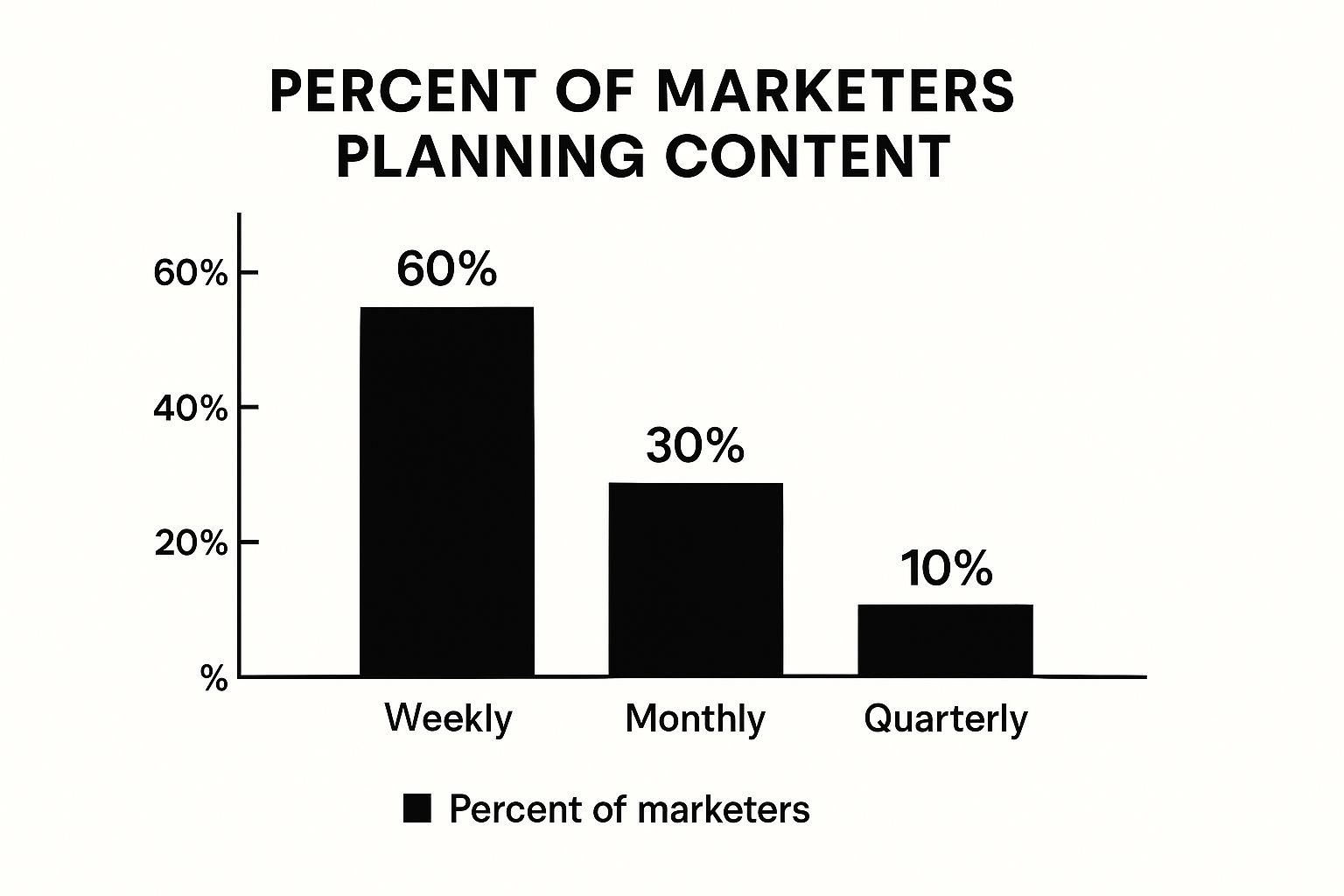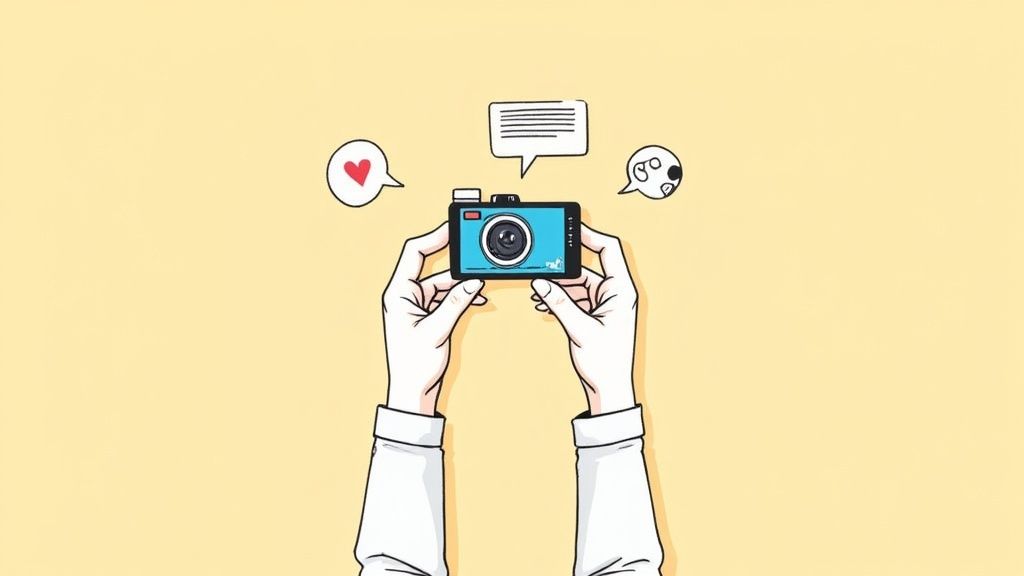Content Planning for Social Media: Your Guide to Success

Understanding Your Audience Across Every Platform
Effective content planning for social media starts with a simple truth: you can't create content that connects if you don't know who you're talking to. Many brands guess, creating generic posts that fail to spark real interaction. The magic happens when you look past basic demographics and understand why your audience stops scrolling, likes, and shares. This isn't about building static buyer personas; it's about connecting with the living, breathing humans behind the usernames.
A solid foundation in social media audience research is the key to developing content that truly hits home. It’s the difference between hoping something works and knowing it will. This means actively listening on different platforms—not just to what people say about your brand, but to how they talk to each other. What slang do they use? What memes are they sharing? What are their passions and pain points when they're not thinking about your product?
From Assumed to Actual: Finding Your Real Audience
Your assumed audience and your actual audience can be worlds apart. A fitness apparel brand might think they’re targeting hardcore gym-goers, but their analytics could show that a huge chunk of their buyers are beginners looking for comfortable, confidence-boosting activewear for walks and yoga. That single insight changes everything, from the tone of your captions to the models you feature. Ignoring this data means leaving a massive part of your community feeling invisible.
To bridge this gap, you need to become a digital anthropologist. Here are a few practical ways to gather real insights:
- Dive into comment sections: Read the comments on your posts, your competitors' posts, and influencer content in your niche. What questions pop up repeatedly? What jokes are landing? This is a goldmine of raw, unfiltered audience sentiment.
- Use platform-native tools: Instagram and TikTok polls, question stickers, and quizzes are fantastic, low-effort ways to ask your audience directly what they want to see. The results can become the pillars of your content strategy.
- Analyze social listening data: Tools can help you track conversations around specific keywords in your industry. This helps you understand broader trends and see where your brand fits into the bigger picture.
Platform-Specific Behaviors and Planning Cadence
Social media is massive. In 2025, with an estimated 5.42 billion users globally and the average person using nearly seven different social networks each month, a one-size-fits-all strategy just won't work. The context of each platform shapes user behavior. Someone scrolling LinkedIn during their lunch break is in a professional, learning mindset. That same person on TikTok in the evening is looking for entertainment and quick bursts of joy. Smart content planning for social media means tailoring your message to fit the user’s mindset on each platform. For a deeper look at this, check out our guide on social media content planning.
To help you visualize this, here's a quick look at how content planning considerations differ across major platforms.
| Platform | Optimal Post Frequency | Best Content Types | Peak Engagement Times | Audience Characteristics |
|---|---|---|---|---|
| 3-5 times/week | High-quality visuals, Reels, Stories, Carousels | Weekday mid-mornings & afternoons | Primarily Millennials & Gen Z, visually driven, trend-conscious | |
| TikTok | 1-3 times/day | Short-form video, trends, user-generated content (UGC) | Late afternoon & evening | Heavily Gen Z, seeks entertainment & authenticity, fast-paced consumption |
| 2-3 times/week | Professional articles, case studies, company news, text-posts | Weekday mornings & lunch hours (9 AM - 12 PM) | Professionals, B2B decision-makers, career-focused, seeks industry insights | |
| 1 time/day | Videos, community-building posts, curated content, links | Mornings & early afternoons | Broad demographic (strongest with Gen X & Millennials), community-oriented | |
| X (Twitter) | 3-5 times/day | Breaking news, quick updates, text-based thoughts, polls, memes | Weekday mornings & lunch hours | News junkies, tech-savvy, engaged in real-time conversations |
This table shows that what works on one platform can easily fall flat on another. A polished corporate video might be perfect for LinkedIn but feel completely out of place on TikTok.
The data below shows how most marketers handle their planning schedules.

The fact that 60% of marketers plan weekly highlights the need to be agile and responsive. At the same time, monthly and quarterly planning provide the strategic backbone, making sure your day-to-day posts are always working toward your bigger goals.
Setting Goals That Actually Drive Business Results
Let’s be honest: setting a goal like “increase engagement” is like trying to get rich by “making more money.” It’s a nice thought, but it’s too vague to create real change. A solid content plan for social media starts by tying every post, story, and video back to a tangible business outcome. Without this link, you're just making noise, celebrating vanity metrics like likes and shares that don’t actually move the needle for your business.
True success comes when your social media efforts align with the numbers that make executives sit up and take notice: revenue growth, customer acquisition cost (CAC), and lead generation. Instead of just chasing likes, a winning brand asks, "How can our content reduce our CAC by 5% this quarter?" or "How can we generate 20% more qualified leads through LinkedIn this month?" This change in thinking turns your social media from a cost center into a powerful growth engine.
Moving Beyond Vanity Metrics
The first step is to get specific. A startup's goal might be aggressive brand awareness, concentrating on reach and follower growth to carve out a space in the market. An established brand, on the other hand, might focus on customer loyalty and upselling, tracking metrics like repeat purchase rates from social referrals. To make sure your social media efforts truly deliver, it's a good idea to use effective goal setting frameworks like SMART (Specific, Measurable, Achievable, Relevant, Timely) to add much-needed structure.
Here’s how this looks in the real world:
- Goal: Increase Brand Awareness
- Vague Metric: More followers
- Better Metric: A 15% increase in branded search queries and a 25% rise in share of voice compared to key competitors over six months.
- Goal: Generate Leads
- Vague Metric: Clicks on a link
- Better Metric: 50 new email sign-ups from Instagram Stories per week with a downstream conversion rate of 3%.
- Goal: Drive Sales
- Vague Metric: High engagement on product posts
- Better Metric: $10,000 in revenue directly attributed to shoppable posts on Facebook and Instagram, tracked with UTM parameters.
Aligning Goals with Audience Behavior
Your goals also need to match how people actually use social media. With global social media penetration hitting 64% and users spending an average of 2 hours and 21 minutes on these platforms daily, your strategy has to be incredibly intentional. This is particularly true for younger audiences; for instance, Gen Z spends about 54% more time on social media than the average user.
This deep engagement means your goals for a platform like TikTok should center on authentic, video-first content that builds community, because that’s what drives their behavior. Digging into global social media statistics can reveal user patterns that help shape your strategy. When you understand these details, you can set goals you can actually influence with your content, instead of just crossing your fingers for a viral hit.
Building a Content Strategy That Feels Authentic
Tired of trying to sound like everyone else online? The brands that really connect with their audiences have stopped shouting into the void. They’ve learned how to mix promotion with genuine value in a way that feels natural, not forced. Your content planning for social media isn’t just about checking boxes on a calendar; it’s about finding your brand's unique voice and building a strategy that truly reflects who you are. This journey starts with defining your content pillars.
Think of content pillars as the core sections of a magazine you publish for your community. If you run a sustainable fashion brand, your pillars might be Ethical Production, Styling Tips, and Conscious Consumerism. These themes act as a guide for every Reel, carousel, or text post you create, making sure everything ties back to your brand's purpose and what your audience wants to see.
Finding Your Brand's Natural Rhythm
To figure out your pillars, you need to find where your brand's expertise meets your audience's curiosity. Don’t just guess what they want. Dig into your audience research and ask yourself some real questions:
- What are the most common questions we get in our DMs and comments?
- What topics is our community genuinely passionate about?
- What unique perspective can we offer that nobody else is talking about?
For instance, a B2B software company might see that its followers are always asking for productivity tips. Instead of just posting about new features, they could build a pillar around "The Future of Work." This lets them share valuable insights on team collaboration, efficiency, and work-life balance, positioning them as a thoughtful expert, not just another vendor. For more specific ideas, especially for professional networks, our guide to creating a LinkedIn content strategy has some great pointers.
A solid strategy balances different content types within these pillars. You can mix educational posts (like how-to guides), entertaining content (think memes or behind-the-scenes glimpses), and community-focused updates (like user-generated content or Q&A sessions) to keep your feed interesting and dynamic.
Generating Fresh Ideas and Staying Relevant
Once your pillars are set, brainstorming content becomes a whole lot easier. Instead of facing a blank page, you can think of specific ideas for each theme. The trick is to create systems that keep the ideas flowing. Many successful brands use a "creative menu"—a list of proven post formats like quote cards, short video tutorials, or data-focused carousels.
This structured method, which you can map out in a content calendar, helps your team stay consistent without sacrificing creativity.

Mapping out your content this way gives you a bird's-eye view, helping you ensure you’re touching on all your pillars and maintaining a consistent, authentic voice.
Technology is also becoming a key player in content planning. By 2025, AI is more than just a tool for writing posts; it's a strategic partner. Recent research shows that over 75% of senior marketing leaders are now using AI for social media tasks. They're using AI-powered tools for deep analytics and brand forecasting, which helps them adjust their strategies on the fly. With nearly half of marketing leaders investing in these tools, content planning is becoming more agile and data-driven, allowing brands to spot and act on opportunities faster. You can get more details in Hootsuite's latest social media trends report.
Authenticity isn’t just about your tone of voice. It's about being consistent, relevant, and delivering on your brand's promise with every single post.
Creating Systems That Actually Get Used
Let's be honest: the most beautifully designed content calendar is useless if it's just gathering digital dust. The best system for your content planning for social media is the one your team actually opens and follows every single day. You need to find a sweet spot that balances solid structure with the flexibility to jump on timely opportunities. A system that's too rigid creates frustrating bottlenecks, but no system at all leads to pure chaos and missed deadlines.
For solopreneurs or very small teams, a simple, color-coded spreadsheet can be an absolute powerhouse. It doesn't need to be fancy. We’ve seen many successful consultants build their entire content engine on a shared Google Sheet with columns for the post date, platform, content pillar, copy, a link to the visual asset, and status (e.g., Idea, In Progress, Scheduled). This low-tech approach is free, accessible, and incredibly effective for staying consistent.
As teams grow, however, those simple spreadsheets can start to feel the strain. This is when dedicated social media management tools become a game-changer. Platforms like Buffer or Sprout Social are built to handle more complex workflows with multiple people. They bring everything from content creation and scheduling to approvals and analytics into one place, preventing that all-too-common nightmare of "final-version-v4.jpg" getting lost in a messy email chain.
Workflows That Don't Cause Bottlenecks
A great system is more than just a tool; it’s a process everyone on the team understands and buys into. The most successful teams often build their workflows around content batching. This just means dedicating specific blocks of time to a single type of task. For example:
- Monday morning: Brainstorm and outline all of the week’s posts.
- Tuesday: Write all the copy.
- Wednesday: Create all the visuals.
This method is a secret weapon against context switching—a major productivity killer—and helps you get into a state of creative flow.
Another critical piece of a functional system is streamlining approvals. Instead of a linear process where a post waits for one person after another, try setting up parallel workflows. For instance, once a post is drafted, it can be sent to both the copy editor and the legal reviewer at the same time. This simple tweak can shave days off your production timeline.
This is what an organized content planning dashboard might look like inside a professional tool.

This visual layout gives a social media manager a bird's-eye view of the entire week or month, making it easy to ensure a balanced mix of content and consistent posting on all channels.
Choosing the Right Tools for the Job
When you start looking at tools, it's easy to get drawn in by expensive, feature-heavy software that promises the world. But often, these tools are overly complicated and end up being underutilized. The goal is to find a tool that fits your current workflow, not one that forces you to overhaul everything. Having a reliable system for consistent content planning across platforms, like mastering your Pinterest content calendar, is vital for success, and the right tool makes it much easier.
To help you decide, here's a quick look at some popular options, whether you're a one-person show or a growing team.
Content Calendar Tools Comparison
Feature comparison of popular content planning and scheduling tools
| Tool | Price Range | Key Features | Best For | Integration Options |
|---|---|---|---|---|
| Google Sheets | Free | Customizable, collaborative, accessible | Solopreneurs, small teams, basic planning | Limited, relies on manual linking |
| Trello / Asana | Free - $$ | Kanban boards, task assignments, deadlines | Small to medium teams, project management focus | Good, connects with Slack, Google Drive, etc. |
| Buffer / Later | $ - $$$ | Scheduling, analytics, visual planning, approval tools | Small businesses, content creators, visual-first brands | Strong, connects with all major social platforms |
| Sprout Social | $$$ - $$$$ | Advanced analytics, social listening, team workflows | Larger teams, agencies, enterprise-level management | Extensive, integrates with CRM and support tools |
Ultimately, the best systems are built for the people using them. They should provide enough structure to keep everyone organized but have the flexibility to adapt when a perfect, unplanned content opportunity pops up. Start simple, get feedback from your team, and don't be afraid to evolve your process as your brand and team grow.
Building Your Content Creation Dream Team
A brilliant content strategy is only as good as the people who bring it to life. Whether your “team” is just you, a small in-house group, or a network of freelancers, defining roles and responsibilities is the secret to scaling your content planning for social media without burning out or sacrificing quality. The goal isn’t to micromanage; it's to create a clear system where everyone knows their part and can do their best work.

This process kicks off with an honest look at your resources. If you're a solopreneur, you wear all the hats: strategist, copywriter, designer, and community manager. For larger teams, it's essential to divide these roles clearly. A common mistake is just assigning "social media" to one person without breaking down the specific skills needed to succeed.
Defining Roles for a Scalable Workflow
Even on a small team, thinking in terms of roles rather than just people can bring incredible clarity to your process. One person might handle multiple roles, but mentally separating the tasks helps ensure nothing falls through the cracks. As you grow, you can then delegate these specific roles to new hires or freelancers.
Think about this structure as a starting point:
- The Strategist: This person is the architect behind your content. They dig into performance data, watch for trends, and make sure every post, story, and video connects back to your business goals and content pillars.
- The Creator: This is your hands-on doer. They write the copy, design the graphics, and shoot and edit videos. This role often demands a mix of skills, making it a prime candidate for outsourcing specific tasks like complex video editing or graphic design.
- The Community Manager: This person is the voice of your brand on the front lines. They respond to comments, jump into conversations, and build real relationships with your audience. Their direct feedback is absolute gold for the Strategist.
In-House vs. Outsourcing: Making the Right Call
Deciding what to keep in-house versus what to farm out is a classic business puzzle. A good rule of thumb is to keep your core strategy and community management in-house. These jobs are deeply tied to your brand’s personality and customer relationships. Tasks that are more technical or just plain time-consuming, like video production or creating high-quality carousel designs with a tool like Lumeo, are often perfect for outsourcing.
When you bring on freelancers, finding the right fit is everything. Look beyond their portfolio and ask about their process. How do they handle feedback? How do they get up to speed with a new brand’s voice? A great freelancer doesn't just check a box; they become a temporary extension of your team. To keep everyone on the same page, give them a detailed brand kit—complete with logos, color palettes, fonts, and a thorough tone-of-voice guide.
A clear, efficient approval workflow is the glue that holds this all together. Instead of a long chain of command that slows everything down, create a simple review process. For example, the Creator drafts a post, the Strategist gives it a quick check for goal alignment, and then it gets scheduled. This approach prevents bottlenecks and empowers your team to move quickly. By defining who does what and building systems to support them, you can build a high-performing team that consistently produces amazing content.
Measuring What Matters and Improving Over Time
Your content planning for social media doesn't stop the moment you hit "publish." Honestly, that's when the real work starts. Drowning in data is easy, but if you know what you’re looking for, those analytics become your guide to making much smarter content choices. It's time to dig deeper than surface-level metrics and figure out what your audience's actions are really saying.
Getting better at social media comes from a constant cycle: create, measure, then refine. This isn't just about a quick glance at your likes and follower count. It’s about finding the patterns in your best-performing posts. Why did that one carousel get 10 times more saves than the others? What was it about that specific video that drove so many clicks to your website? Answering these questions is how you find your breakthroughs.
From Data Points to Actionable Insights
First things first, you need to set Key Performance Indicators (KPIs) that actually connect to the business goals you defined earlier. If your main goal is to build a community, your most important KPI is the engagement rate (comments, shares, and saves), not just how many people saw the post. If you're trying to drive sales, then click-through rate (CTR) and conversion rate from your social channels are the numbers that matter most.
Tools like Google Analytics are fantastic for seeing how your social media work translates into website traffic and what people do once they get there.
This kind of dashboard doesn't just show you where your visitors come from. It reveals how engaged they are on your site, helping you draw a straight line from social media performance to real business results.
Once you start collecting this information, you can create a process for continuous improvement. This means setting aside regular time to review your analytics to see what’s hitting the mark and what’s falling flat. Our article on measuring content performance offers a great framework for what to track. This data-first approach lets you make strategic changes based on evidence, not just a gut feeling.
A Framework for Continuous Improvement
Having a structured way to optimize your content will keep your strategy effective and prevent it from getting stale. This isn't a one-and-done task; it's an ongoing commitment to being better than you were last month.
Here’s a simple framework to get you started:
- Monthly Performance Reviews: Carve out time every month to go over your core KPIs. Are you noticing any trends? Is engagement starting to drop on one platform? Is a certain type of content consistently outperforming everything else? Use these takeaways to tweak your content calendar for the next month.
- A/B Testing Content: You don't need fancy software to A/B test on social media. It can be as simple as trying different visuals (like a custom graphic vs. a real photo), experimenting with short vs. long captions, or testing different calls-to-action (CTAs). Run these small experiments, keep an eye on the results, and let the data inform your creative decisions.
- Quarterly Strategy Sessions: Every three months, zoom out and look at the big picture. Are you still on course to hit your yearly goals? Have new trends popped up that you should experiment with? This is also the perfect time to do a quick check on your competitors to see what's working for them and where you might find an opening.
Think of your analytics as a direct conversation with your audience. They are telling you exactly what they want more of. When you listen closely and adapt your plan accordingly, you turn your social media from a simple broadcast tool into a powerful engine for connection and growth.
Your Path Forward
Turning this framework into real-world results means taking decisive action. Think of content planning for social media not as a one-time setup, but as an ongoing process of tuning and tweaking. The key is to start with the changes that will give you the biggest return on your effort. Don't try to change everything all at once.
Instead, pick one or two areas to improve first. Is your audience research a bit thin? Start there. Are your content creation workflows chaotic and stressful? Focus on building a simple, repeatable system before anything else.
From Plan to Practice
Once you know your starting point, set some realistic timelines. It might take a full month to build out your first real content calendar and fill it with ideas. You might not see a noticeable jump in your key metrics for a whole quarter. The initial burst of motivation will eventually wear off, so building momentum is crucial. Celebrate the small victories, like finishing your first week of batched content creation or getting great feedback on a new post format.
As you start putting these strategies into action, keep an eye out for a few warning signs that your plan might need a course correction:
- Stagnant Engagement: If your likes, comments, and shares have flatlined for more than a month, it’s a signal to revisit your content pillars and what you know about your audience.
- Team Burnout: Are your creators constantly missing deadlines or feeling swamped? This often means your workflows are too complex or your expectations are a bit too high.
- Metric Mismatch: If your social media numbers are going up but your core business goals aren't budging, you have an alignment problem. It’s time to go back and reassess what you’re actually measuring.
Lasting success on social media comes from your ability to adapt. Make it a habit to regularly review what’s working, what isn’t, and—most importantly—why. By staying flexible and committing to gradual improvement, you’ll transform your social media from a daily chore into a predictable, powerful engine for growth.
Ready to turn your best content ideas into stunning, high-performing visuals? Create your first carousel for free with Lumeo and see how easy it is to capture attention and drive engagement.